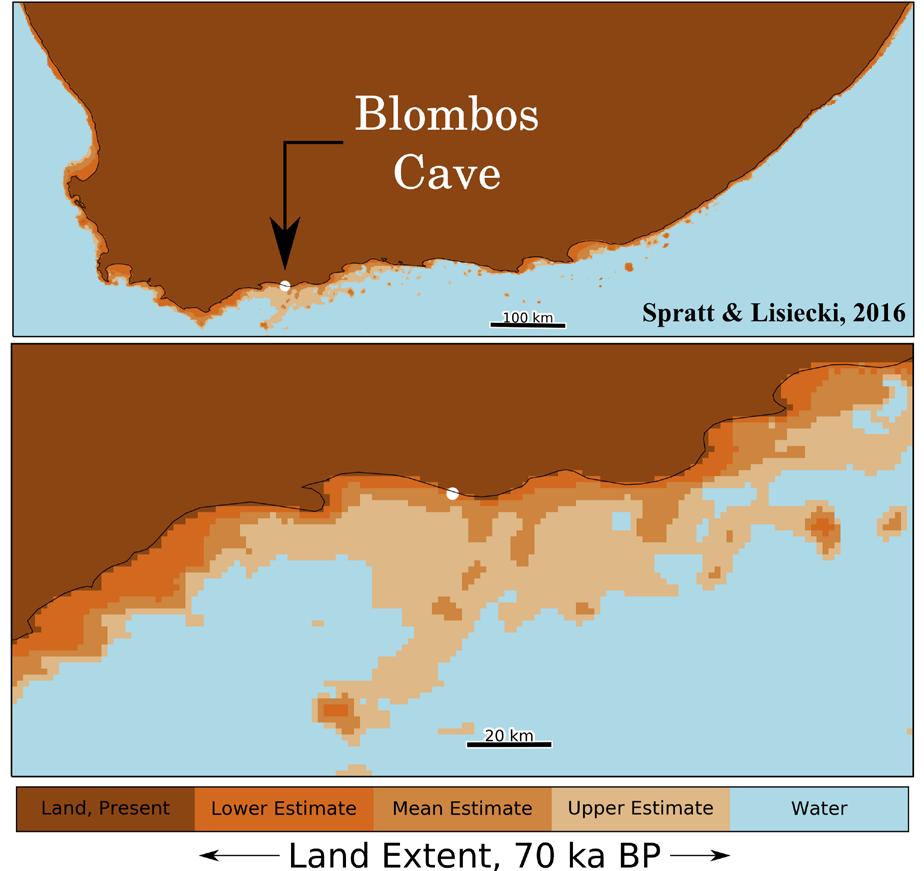
3 minute read
Deciphering ancient climates
Spratt, R. M. and Lisiecki, L. E.: A Late Pleistocene sea level stack, Clim. Past, 12, 1079–1092, https://doi.org/10.5194/cp-12-1079-2016, 2016.
Fig. 2 : WRF model surface air temperatures near Blombos Cave through an arbitrary winter month, 70 000 years before present. The model was run twice, once with the present day coastline (blue curve) and once with the coastline defined by the lowest sea level estimate at 70 000 years ago i.e. with the coast further south, away from Blombos Cave (red curve). Note the much lower night-time temperatures and larger diurnal range calculated when the coast is further south (red curve), due to the reduced marine influence.
One crucial component of the climate reconstruction work within SapienCE is climate modelling. By using global models, we can simulate the characteristics of large scale atmospheric circulation and obtain, for example, the temperature and distribution of precipitation on the Earth’s surface 65 000 years ago. However, the level of spatial detail (i.e. horizontal resolution) in global models is quite low, thus providing us with a rather poor estimate of what was going on regionally and locally.
To overcome this problem, we use a ‘regional model’, which runs on a predefined, limited area. The regional model uses the output from the global model as its input, and generates output on a much smaller scale – hence we describe this process as ‘downscaling’. Yet, this is not some kind of interpolation to redistribute low-resolution data statistically: The regional model uses atmospheric physics and dynamics to calculate all meteorological variables for each grid cell almost from scratch. Even on supercomputers this ‘dynamical downscaling’ takes a lot of time.
We use the output from the Norwegian Earth System Model (NorESM) global model to perform dynamical downscaling in the Weather Research and Forecasting (WRF) regional model. The NorESM data points (i.e. centers of grid cells) are ~400 km apart, giving coarse spatial resolution data which is not very useful to assess regional and local climate. The WRF model downscales NorESM output to a horizontal resolution of 12 km. This allows us to derive much more robust interpretations of model output, and makes it possible to compare this more detailed information with proxy records of climate within the model domain. In short, we can assess the quality of both model and proxy data by comparing them.
However, setting up a regional model to simulate past climate is not as straightforward as it might sound. The model uses parameters such as vegetation cover, coastline position and sea surface temperatures in its calculations, most of which are readily available for the present day. Unfortunately this is not the case for the past. For instance, the Earth was in an ice age between 50 000 and 100 000 years ago and the sea level was lower, so a lot of land area that is submerged today was exposed then. This has important implications for climate at coastal sites such as Blombos Cave, since the presence or absence of marine influence may lead to dramatic differences in temperature and precipitation patterns.
With great challenges come great opportunities. Using a regional model, one can determine how sensitive the local climates are to these long-term changes on the Earth’s surface. This is achieved by running the model several times, each time modifying a parameter that we are uncertain about. For example, we could lower the sea level and run the model with this new ‘setting’. By comparing the output from several runs conducted using different settings, we can determine the sensitivity of the model to sea level, and therefore how accurately we need to know past sea-level to get a good model result. Similar sensitivity simulations can be designed for other parameters, which helps us to understand what the more important factors in deciphering past climates are.
All this work has commenced in 2019 and is still in progress. Preliminary results show that paleo-coastline and paleovegetation might have had significant impacts on local climates in southern Africa. We plan to focus on the regional changes from 82 000 to 70 000 years ago, which is an important period for the evolution of modern human behaviour.
Fig. 2











